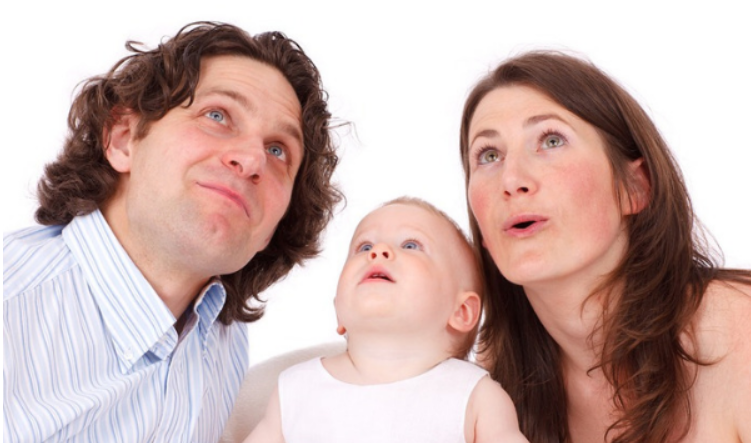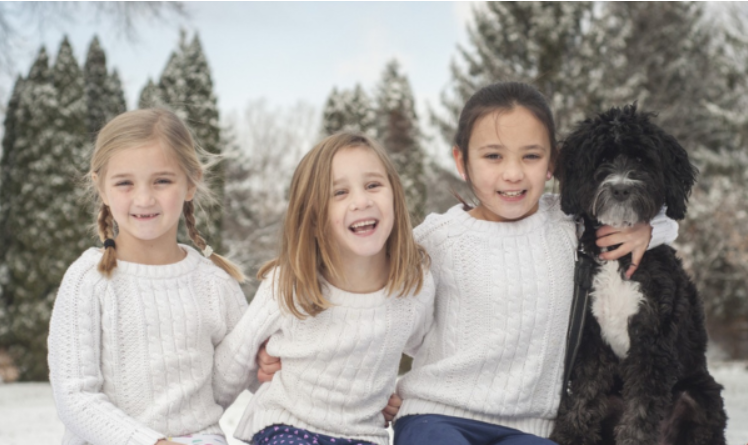What is joint attention? What made you wonder about this term?
If you are a parent of a child with a speech-language delay or autism then you may have heard it before.
However, it’s is a term that all new parents should become familiar with.
This is because joint attention is a precursor to spoken language.
What Is Joint Attention?
In simplest terms, it is when 2 individuals have their attention on the same thing (this can be an object, person or experience).
Another term which is sometimes used to refer to joint attention is shared attention.
One individual gets the attention of the other through eye gaze, gestures (pointing), vocalizations or words.
The end result is both people looking at the same object, person, event, etc. and then looking back at one another again.
The key part of joint attention is the ability to share eye gaze with another person with intent.
It is the basis of back and forth conversations that will occur later on.
When Do Children Start Exhibiting Joint Attention?
In its most basic form (sharing gaze, making eye contact), joint attention can be seen when babies between 2–3 months old interact with their parents/caregivers (Reddy, V. 2005).
The infant looks at the parent when the parent/caregiver is speaking.
However, it isn’t until 6 months or later that intentional joint attention begins emerging.
A neurotypical 6 month old will be able to follow the gaze of his parent by turning to whatever the parent is looking at.
At about 8–9 months, babies begin pointing.
They will point as well as use eye gaze to direct someone’s attention to the object they are looking at.
But don’t worry if your child isn’t pointing yet, some children don’t point until they are closer to 12 months.
As long as your little one is using eye gaze to draw your attention to an object of interest, everything is most likely fine.
Once a baby is over 9 months you will see gaze checking which represents true joint attention.
Gaze checking means that the baby will look and/or point at something and then look to a parent/caregiver to see if the parent is also looking at the same object.
Children on the autism spectrum often struggle with joint attention which can make it harder for them to develop functional language skills.
The Role Of Joint Attention In Language Development
Joint attention is important for language development, specifically understanding and producing words as well as learning new words.
It is one of the earliest predictors of future language skills.
The words that children hear during an interaction involving joint attention are strongly linked to their vocabulary development.
For example, a 12 month old has drawn their mother’s attention to a ball.
The mother can respond in a few different ways.
One could be to ignore the communicative attempt or respond with something like “ya, I see it”.
Alternatively she could respond with “oh, you like the ball, do you want to play with the ball? Let’s throw the ball”.
The second interaction will lead to a lot more learning for that child.
They have heard the word ball 3 times!
It will be a lot easier for the child to learn and eventually say the word “ball”, because they now have a reference.
Some research has also shown that when joint attention occurs during book reading, it can be linked to reading ability and further language learning as the child gets older (Visual Language and Visual Learning Science of Learning Center. (2012, June). Eye Gaze and Joint Attention (Research Brief No. 5). Washington, DC: Amy M. Lieberman).
What If My Child Is Not Exhibiting Joint Attention
Don’t panic, but be on the lookout.
In the next section I will list some ideas that you can implement to help your little one develop joint attention.
A child needs to do certain things in order for true joint attention to be observed.
For example, a baby needs to be able to attend to and look at a communicative partner, they need to be able to follow another person’s gaze or pointing, they should be able to look from objects to people and vice versa and finally they need to be able to get another person’s attention shifted to whatever it is they are interested in.
Bhat, A.N., Galloway, J.C. and Landa, R.J. (2010) found that children who do not develop joint attention skills are more at risk for developmental delays, specifically with respect to social skills and language development.
If by 12 months your child is still not showing any attempts at joint attention (eye gaze, intentionally drawing caregivers attention to an object of interest, pointing, etc.) it is time to bring this up to your child’s doctor.
If your child is also not using any words or word approximations (e.g. “bah” for “ball”), a full speech–language assessment would be warranted.
You are your child’s best advocate, so if you feel that something isn’t right, push to have your child assessed by the appropriate professional, in this case it would be a developmental pediatrician or a speech-language pathologist.
How Can I Help My Child Improve Joint Attention?
Social skills are a fundamental part of language development.
A large reason for speaking is to communicate with others.
Therefore, a child must learn how to interact with others non-verbally before spoken language will happen.
Communicative intent (i.e. A reason for communicating) must be present in order for spoken language to follow.
Here are some ways you can work on improving your child’s joint attention skills:
♥ Point often when you are talking to your child.
♥ Make a point of turning your head to look at an object of interest while pointing and verbalizing what you see, for example “look at that big ball”.
♥ Hold up a toy you know your child likes and say “look”.
♥ Use hand over hand guidance (if your child will allow this, don’t force it) to facilitate pointing.
This means taking your child’s hand and isolating their finger to make them point to an object.
A good time to work on pointing is during book reading.
You can point to a picture while labeling it, for example “there’s a dog”, then ask your child “do you see the dog?”, at this point you could use hand over hand to have your child point to the picture of the dog.
You can also do this when you and your child are looking at some of their favorite toys.
♥ Follow your child’s lead.
If your child is interested in something they are more likely to point it out to you as well as engage with your more.
You can show interest by commenting on the toy while pointing, for example “you like the teddy bear, he’s so soft”.
You can take it a step further by pointing to your eye and then looking at the bear.
♥ Play hide and seek with a favorite toy.
Let’s take a toy truck as an example.
Make sure your child has seen the truck. You can say “look at the truck” while pointing to it.
Once your child has looked at it, move it to another spot (your child should be watching you do this), then ask “where did the truck go?”
Wait to see if your child will look at the truck (and maybe even point to it).
If this doesn’t happen, point at the truck, look at the truck and say “there’s the truck”, make sure to look back at your child.
At this time you can take your child’s finger to point to the truck if they aren’t doing so themselves.
Again, this works best if your child is actually interested in the toy.
I hope that I have answered the question “what is joint attention?” for you.
I have tried to keep the information as straightforward as possible, because honestly all of this stuff can get quite overwhelming.
If you have any questions or comments, please share in the comment section below!




